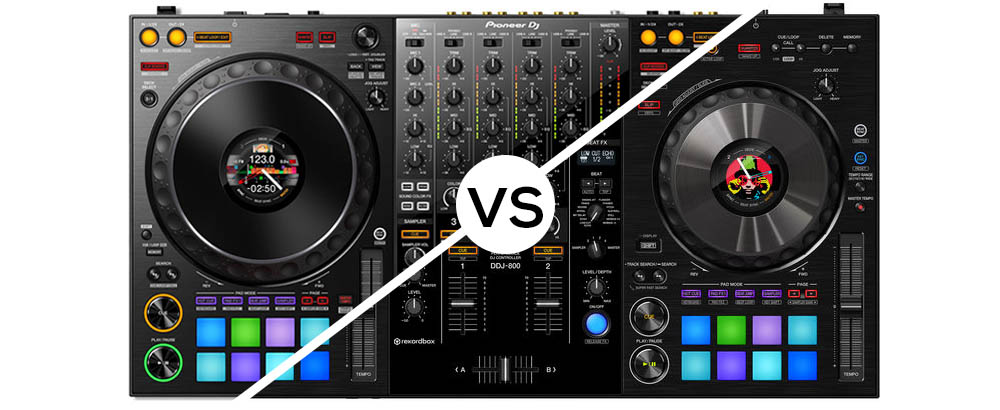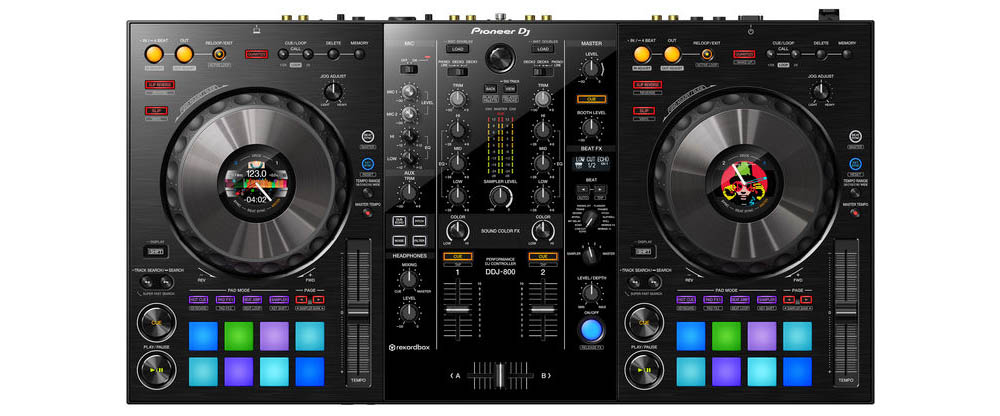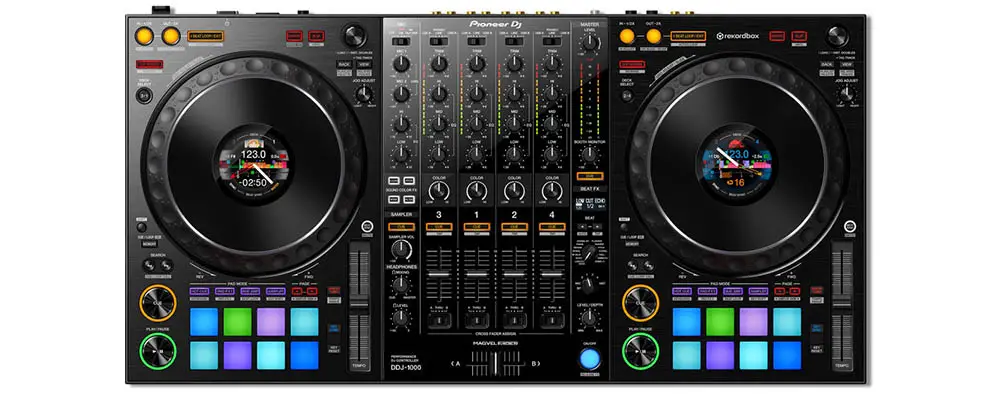Pioneer DDJ-800 vs DDJ-1000 – Which One Should You Choose?
This is a heavyweight clash! Pioneer has created some insanely powerful high-end controllers and these two are valuable members of this range. They’re two of the most popular mid to high-end controllers and they’re certainly two of the best.
Both of these controllers are clearly up to the mark for any form of DJing, amateur, semi-pro, pro – they’re good for anything you can throw at them!
- Both pack pro hardware, awesome layouts, wide selections of extra assignable FX, pads and encoders.
- Both are designed for a largely ‘hands-off the laptop’ approach which allows you to focus on the decks themselves.
- Both have handy LCD displays at the centre of each deck and quality CDJ-like jogwheels

So, how do you split these two excellent controllers?!
Pioneer DDJ-800

The Pioneer DDJ800 actually came out after the DDJ1000! It’s stripped down, smaller, lighter and is more compact in every sense. It weighs a quarter less than the DDJ1000 – almost 1.4kg – which does make a considerable difference. The alternate sizing of this controller differentiates itself from its bigger brother – it really isn’t the same dominant beast as the DDJ1000 and it won’t hog an entire DJ table or desk. The result is a pro controller which you can transport with relative ease.
Build and Features
The build quality of this controller is top-class. Let’s not forget that even though some see it to represent a ‘downgrade’ from the DDJ800, it still is ultimately built for pro use and thus, Pioneer hasn’t exactly toned it down that much at all.
It has two lovely decks with awesome LCD displays which feature decent-res waveforms and other key song info like BPMs, duration, cue-point positions, etc. You can adjust the ‘feel’ of the wheels, too, which is great for those who want to align them to feel as close to CDJs as possible.
It has a couple of phono/line inputs on the back so you could run external decks through but it’d be hard to operate them via the two-channel mixer. You can also connect two mics. It uses XLR and RCA outputs.
The mixer itself is two-channel, as already mentioned, has 3-band EQs and high-performance faders. It’s just like having a ‘proper’ Pioneer mixer in the centre of the controller. Performance pads, a beat FX panel (familiar to those who own Pioneer mixers) and loop controls top off this controller’s fully-featured design – it has the basics and the extra trimmings required for serious DJing.
Performance
Running on RekordBox, which is included, this controller fits firmly in Pioneer’s modern DJ ecosystem and it’s sure to find its way into small venues as a permanent booth fitting. This controller actually ‘unlocks’ RekordBox installed on any controller, or in other words, it is its own licence. So, if your friend has a RekordBox demo version then you can plug this controller in and use it as the full version.
The DDJ-800 performs awesomely for two deck mixers – you can use it with 4 channels, it’s just not very intuitive or easy. But, when you factor in the crazy possibilities of using FX, loops and pads in your performances, suddenly 4 decks doesn’t feel so irrelevant as it might’ve done a few years back!
The jogwheel displays combined with its comprehensive array of modules means that this controller can be used effectively without needing to look much at a laptop. In short, you can take a ‘no laptop’ approach if you like, loading, mixing and matching songs from the controller itself!
Pioneer DDJ-1000

The DDJ1000 pretty much looks like a DJM600 mixer welded to some CDJs in one big combined unit. It’s obviously much, much more and has become a superb controller for pro users around the world. It has everything needed to execute superb technical mixes and is engineered to perfection.
Beyond this point, we can only find Pioneer’s super-expensive top-spec RZX series – essentially the Nexus of the Pioneer controller ecosystem. If you want a pro controller with 4 channels but don’t need an RZX then this is your game.
Build and Features
An electronic device this size takes some building. It’s strong, durable enough for such a big piece of machinery and it’s laid out very well, making the most of its large frame to accommodate so many features. At its core, it has a 4 channel mixer that very much resembles a DJM Pioneer DJ mixer. The Magvel crossfader is top-class and all the other encoders, channel faders, misc controls, etc, are right up to expected quality levels.
The decks themselves feel very similar to CDJs, if you want or need them to. They have a mechanical motion which feels smooth but deliberate – neither too smooth nor too resistant. The LCD displays at the centre of each deck are incredible and display high-res waveforms alongside key song info like BPM, song times and cue points.
These displays are so handy as they allow you to pay less attention to your laptop and more attention to your mix. You can also connect two mics which can hook up to your FX modules. It use standard XLR and RCA outputs.
Performance
This is a 4-channel controller and it’s optimised for 4-channel use. It’s very easy to operate 4 decks with the 1/2 and 3/4 switch buttons next to each deck and with 4 complete mixer channels, controlling all 4 channels at once is efficient and effective.
This is the key aspect of this controller and the key point at which it diverges from the DDJ-800. Another major difference is that the DDJ-1000 has two USB slots for connection of two laptops, enabling collaboration and seamless DJ switching – this is a dealbreaker for many clubs!
Aside from that, you have the same beat FX modules, performance pads, loop sections, etc.
Conclusion: Summary of Differences
Ultimately, in most areas, we have two similar controllers. They were created to compliment each other with their own slight angles towards different users.
The DDJ-800
The DDJ-800 is smaller, lighter and is stripped down especially in the mixer section. If you only ever use two channels, then go for this controller. You’ll 100% be paying for channels you don’t need by opting for the DDJ-1000!
The DDJ-800 also loses the top-spec mechanical jogwheels of the DDJ-1000, though they do feel close enough in reality.
Aside from that, the DDJ-800 has been ‘modernised’ in its application of RekordBox, which you do not need a licence for. You simply plug the controller in and it ‘registers’ the software there and then, allowing you to use the full version of it, even if there is no full version licence on the PC. The controller is essentially its own licence key.
The DDJ-1000
The DDJ-1000 adds two channels for proper 4 channel mixing capabilities. If you need this functionality, or want it badly, then the DDJ-1000 is the answer!
Aside from that, it packs CDJ-like jogwheels, has more inputs for external hardware, enables two laptops to plug in simultaneously (often a dealbreaker in club settings) and features a top-spec crossfader.
Unlike the DDJ-800, you will need to plug this into a laptop with a full licenced version of RekordBox for it to work.
So, that’s it! Two awesome controllers with some fine lines separating them and some bold lines separating them. Either way, these controllers are some of Pioneer’s best and they’ve made their ways across the world in the hands of many DJs.
You may also like: